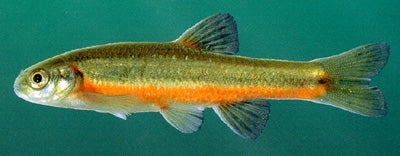FLAME CHUB
SCIENTIFIC NAME: Hemitremia flammea
CHARACTERISTICS: Is a short species with a round body form in profile. The head is small, blunt, and rounded. Breeding males are striking, with lower sides that become flame red while their venters remain light. In each individual, the anterior base of the dorsal fin has a red spot, and the light olive back and sides are streaked with golden brown. A dark lateral band runs between the golden stripes, ending in a small but separate spot at the base of the caudal fin. See Jordan (1878a) for original description.
ADULT SIZE: 1.6 to 2.4 in (40 to 60 mm)
DISTRIBUTION: The flame chub is found only in the Tennessee, Cumberland, and Coosa river drainages. It regularly occurs throughout the Tennessee River drainage in the Cypress Creek, Elk River, Swan Creek, Flint River, and Paint Rock River systems, where it is most frequently encountered in springs, spring runs, and tributaries draining the Highland Rim. Isolated populations occur in tributaries to Choccolocco Creek in Calhoun and Talladega counties.
HABITAT AND BIOLOGY: This species prefers springs and small spring-fed streams, where it is sometimes abundant. It is an early spawner, beginning in January and continuing to early June. Spawning usually peaks in March, when we observed gravid individuals in association with slackwater darters, Etheostoma boschungi, in spring seeps flowing through pastures. Foods of the flame chub include midges, worms, snails, filamentous algae, and terrestrial insects (Sossamon, 1990).
ORIGINAL DESCRIPTION: Jordan and Gilbert described the flame chub in 1878.
ETYMOLOGY:
Hemitremia means half aperture, referring to the incomplete lateral line.
Flammea means flaming, referring to the bright red colors in breeding males.
The copyrighted information above is from Fishes of Alabama and the Mobile Basin.






